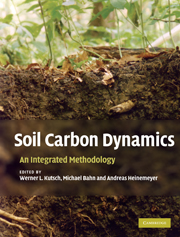Book contents
- Frontmatter
- Contents
- List of Contributors
- Preface
- Editorial Acknowledgements
- 1 Soil carbon relations: an overview
- 2 Field measurements of soil respiration: principles and constraints, potentials and limitations of different methods
- 3 Experimental design: scaling up in time and space, and its statistical considerations
- 4 Determination of soil carbon stocks and changes
- 5 Litter decomposition: concepts, methods and future perspectives
- 6 Characterization of soil organic matter
- 7 Respiration from roots and the mycorrhizosphere
- 8 Separating autotrophic and heterotrophic components of soil respiration: lessons learned from trenching and related root-exclusion experiments
- 9 Measuring soil microbial parameters relevant for soil carbon fluxes
- 10 Trophic interactions and their implications for soil carbon fluxes
- 11 Semi-empirical modelling of the response of soil respiration to environmental factors in laboratory and field conditions
- 12 Modelling soil carbon dynamics
- 13 The role of soils in the Kyoto Protocol
- 14 Synthesis: emerging issues and challenges for an integrated understanding of soil carbon fluxes
- 15 Appendix: Towards a standardized protocol for the measurement of soil CO2 efflux
- Index
- References
3 - Experimental design: scaling up in time and space, and its statistical considerations
Published online by Cambridge University Press: 11 May 2010
- Frontmatter
- Contents
- List of Contributors
- Preface
- Editorial Acknowledgements
- 1 Soil carbon relations: an overview
- 2 Field measurements of soil respiration: principles and constraints, potentials and limitations of different methods
- 3 Experimental design: scaling up in time and space, and its statistical considerations
- 4 Determination of soil carbon stocks and changes
- 5 Litter decomposition: concepts, methods and future perspectives
- 6 Characterization of soil organic matter
- 7 Respiration from roots and the mycorrhizosphere
- 8 Separating autotrophic and heterotrophic components of soil respiration: lessons learned from trenching and related root-exclusion experiments
- 9 Measuring soil microbial parameters relevant for soil carbon fluxes
- 10 Trophic interactions and their implications for soil carbon fluxes
- 11 Semi-empirical modelling of the response of soil respiration to environmental factors in laboratory and field conditions
- 12 Modelling soil carbon dynamics
- 13 The role of soils in the Kyoto Protocol
- 14 Synthesis: emerging issues and challenges for an integrated understanding of soil carbon fluxes
- 15 Appendix: Towards a standardized protocol for the measurement of soil CO2 efflux
- Index
- References
Summary
INTRODUCTION
Accurate measurement of the soil CO2 efflux is critical for the assessment of the carbon budget of terrestrial ecosystems, since it is the main pathway for assimilated carbon to return to the atmosphere, and only small changes in the soil CO2 efflux rate might have important implications on the net ecosystem carbon balance. Due to this central role in the terrestrial carbon cycle, soil CO2 efflux has been measured throughout all biomes, and covering all principal vegetation types. Using simplified regressions of soil CO2 efflux measurements reported in the scientific literature, the total amount of carbon emitted as CO2 by soils worldwide has been estimated at approximately 68–80 Pg (1995; Raich et al., 2002), representing the second largest carbon flux between ecosystems and the atmosphere. This amount is more than ten times the current rate of fossil fuel combustion and indicates that each year around 10% of the atmosphere's CO2 cycles through the soil (Prentice et al., 2001). Thus, even a small change in soil respiration could significantly intensify, or mitigate, current atmospheric increases of CO2, with potential feedbacks to climate change. In fact, soils store more than twice as much carbon globally than the atmosphere (Bolin, 2000) and consequently contain a large long-term potential for the carbon cycle climate feedback. Applying results from small-scale experiments to larger areas is necessary in order to understand the potential role of soils in sequestering or releasing carbon under changed climatic conditions, and to inform management and policy makers about likely consequences of land-use changes on carbon fluxes and stocks in specific regions.
Information
- Type
- Chapter
- Information
- Soil Carbon DynamicsAn Integrated Methodology, pp. 34 - 48Publisher: Cambridge University PressPrint publication year: 2010
